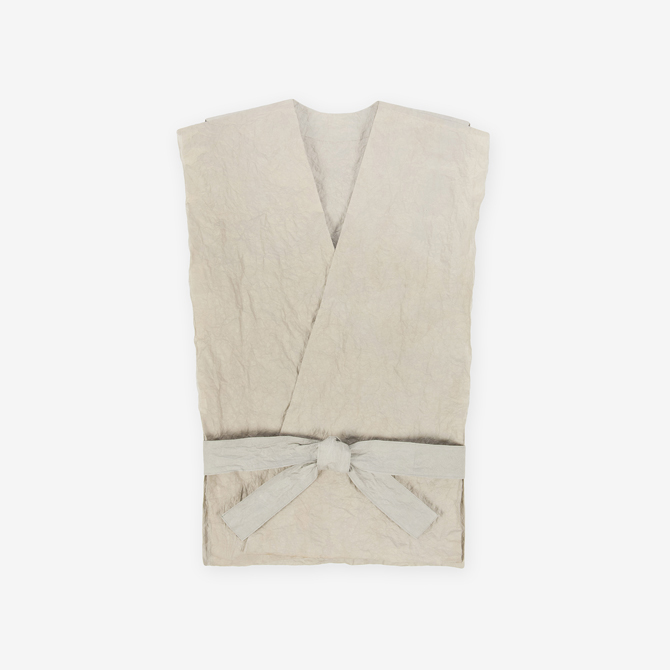Exhibitions
COSMIC WONDER
Kamino-hikarino-awa
Kamikoromo

Cosmic Wonder’s kamikoromo get their white color from the kozo plant. The ume flower color comes from an Akane herbal dye. The sumi color comes from a wildflower herbal dye.
Paper has long been celebrated in Japanese life for the important role it plays in many rituals, ceremonies, and countless everyday activities. In ancient times, Buddhist priests pasted together paper scraps to make kimonos. This tradition lives on in the form of kamikoromo and in the ceremony called ‘omizutori’, which is performed at the Todaiji Buddhist temple in Nara. Ippen Shonin (St.Ippen) traveled throughout Japan wearing kamikoromo.
From the Muromachi period onward, kamikoromo spread out through the samurai culture. The one worn by Kenshin Uesugi (one of the most powerful lords of the Sengoku period) is thought to be the oldest surviving kamikoromo. Toyotomi Hideyoshi (a preeminent daimyo) owned a kamikoromo haori (the reverse side was dyed with kobai). By the middle of the Edo period, the use of these paper robes had expanded to the general population. This is the time of Basho, the greatest haiku poet and a wearer of kamikoromo.
Their lightness and heat-retaining quality made them popular among travelers and traveling haiku poets. Kamikoromo embody the sense of wabi-sabi, emphasizing the rustic beauty of nature. In the present day, techniques for the production of traditional paper clothing are still practiced in Shiroishi, Miyagi Prefecture.
Today, kozo, mitsumata and gampi are the principal raw materials for washi. Kozo is prized for its long, tough fibers. Kozo is cut at the root and steamed in a barrel over a fire in order to separate the bark. The bundles of fibers are placed in a cold stream for one to three days. The branches are boiled and stripped of their outer bark and then dried. The fibers are then boiled, placed in running water, and naturally bleached. The rinsed fibers are placed in a strainer floating in water for further cleaning and then laid on a board and beaten. Once they have dried overnight and have been softened by stamping or hand-rubbing, they are ready to be made into washi.
COSMIC WONDER Kamino-hikarino-awa collection event will go on a tour to the following region in Japan.
[ Schedule ]
KAGURE, Osaka 9/5 – 15
URBAN RESEARCH DOORS, Minamisemba 9/19 – 29
CIY, Morioka 10/3 – 12
STARDUST, Kyoto 10/10 – 18
OUTBOUND, Kichijoji 10/21 – 11/2
KAGURE, Marunouchi 10/24 – 11/1
MM BOOKS MINO, Mino 11/7 – 15
ISETAN SHINJUKU MEN’S 2F, Shinjuku 11/11 – 24
OU, Nagoya 11/17 – 23
PENNY RAIN, Kiryu 10/20 – 21
POST IN TIME, Maebashi 10/22 – 23


 Facebook
Facebook Twitter
Twitter